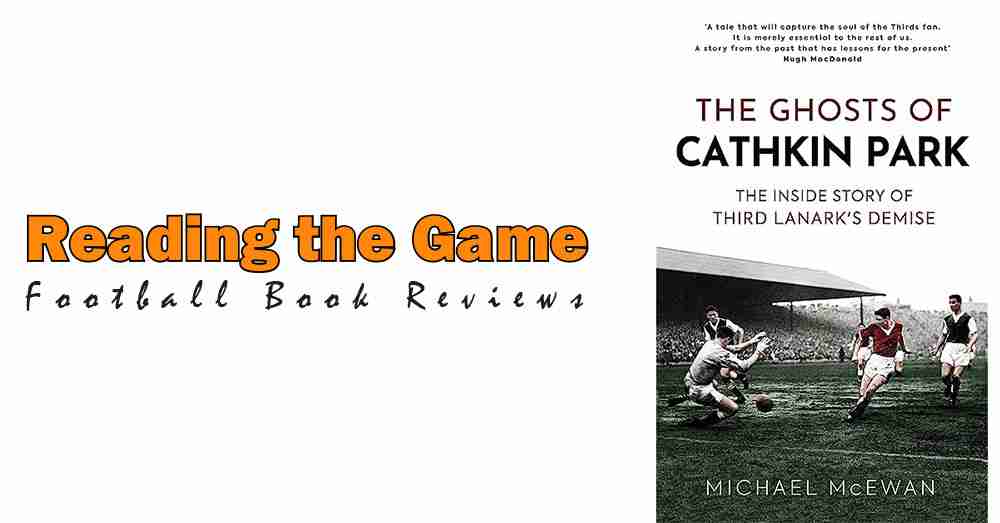One of the biggest football stories this week has been Rangers’ attempts to secure Cup glory on both European and domestic fronts, so it is fitting that I’ve been reading about another Glasgow club, whose closure remains shocking half a century after it happened. The Ghosts of Cathkin Park by Michael McEwan is an examination of how Third Lanark AC – a founder member and former Champion of the Scottish Football League – ceased to exist at the same time as their cross-town rivals Celtic and Rangers were chasing continental glory.
I came to this book thanks to reading Scotland’s Lost Clubs by Jeff Webb (which I reviewed as part of this series) sparking an interest in what happened to the Hi-Hi. When my old friend The Wandering Tractor gave it a five-star review, I felt certain that The Ghosts of Cathkin Park was a book I’d enjoy.
The subtitle is ‘The Inside Story of Third Lanark’s Demise’ and this beautifully written tale certainly delivers on that promise. In addition to drawing on press reports and the Board of Trade’s assessment of the club’s management, surviving former players are also given space to tell their stories. Remarkably, the son of the club’s final owner, Bill Hiddleston, also spoke to McEwen and told his family’s side of the story.
The result is a compelling and well-paced account of the (utterly avoidable) death of a football club. It was a situation more than a decade in the making, with the first seeds being sown in 1954 when Bill Hiddleston joined the Board and then became the First Tam’s manager. However, he sanctioned a transfer without consulting his colleagues and was forced out of the club.
Having spent years building up his shareholding, Hiddleston seized control of the club in 1962. This caused several Directors and Manager George Young to resign. Young’s parting shot was “Good luck to Thirds and God help them”.
McEwan then explains how, over the next following five years, Thirds were hollowed out from the inside, by the very people who were supposed to be developing it. Bill Hiddleston’s penny-pinching and utter disregard for obligations such as providing a new ball for each match (old ones would be whitewashed instead) demoralised players and fans and drove supporters away. Cathkin Park itself became dilapidated and visiting teams found they had to bring soaps and lightbulbs with them when travelling to play the Hi-Hi because Thirds didn’t supply such basic provisions.
The Ghosts of Cathkin Park details that Hiddleston planned to sell Third Lanark’s land for housing and move the club to East Kilbride. It also presents evidence that cash handed to Bill Hiddleston by club staff never reached its bank account, although what did happen to it isn’t established.
An unexpected twist in this tale is that Bill Hiddleston’s son, Crawford, was interviewed for the book. He challenges the widely held belief that Third Lanark provided a financial cushion for his family which by his account “was left somewhere between poor and penurious by his father’s death”, which occurred just a year after Thirds were closed down.
The parallels between Third Lanark’s demise and the financial chaos at Rangers are skilfully drawn and McEwan explains how, thanks to changes in insolvency law, Rangers were able to survive in a way that Thirds had not been. Ironically, the Lazarus-like rebirth of the Light Blues saw Joe Aribo give them the lead in the Europa League Final in midweek. Aribo’s first club, Staines Town have just been relegated, are currently owned by a man who refuses to allow the club to play at its home ground (which he tried and failed to buy) and technically insolvent. This Twitter thread by James Cave provides useful context. That clubs are still being mismanaged in this way is a damning inditement of football’s regulators who should, perhaps, be asked to read this book.
The Ghosts of Cathkin Park is a terrific, if sad, book. It’s been meticulously researched and is cleverly structured to place what happened to Thirds both alongside contemporary events at Celtic and Rangers and in a more modern context. I’d suggest it as a ‘must-read’ for anyone interested in football history or how the game is run. It’s a cautionary tale which remains as relevant today as it did in 1967.
The Ghosts of Cathkin Park is published by Birlinn, via their Arena Sport imprint. You can get a copy from Stanchion, the independent football bookshop, or in all the other places books are sold.
